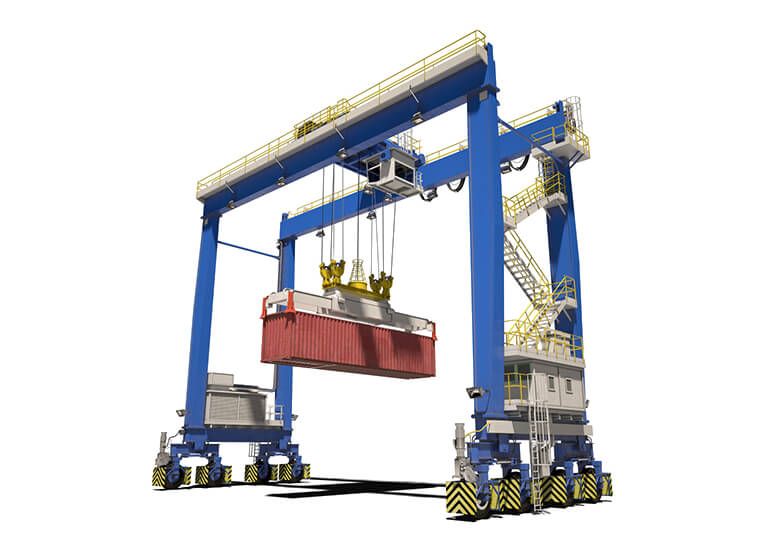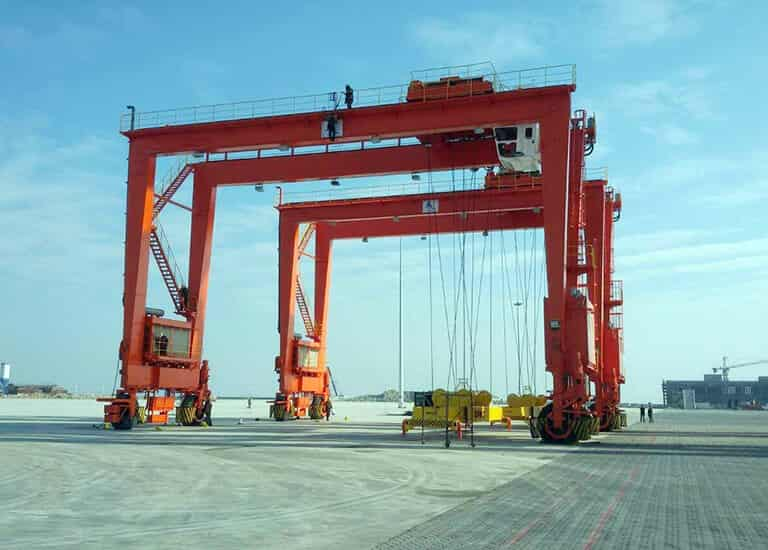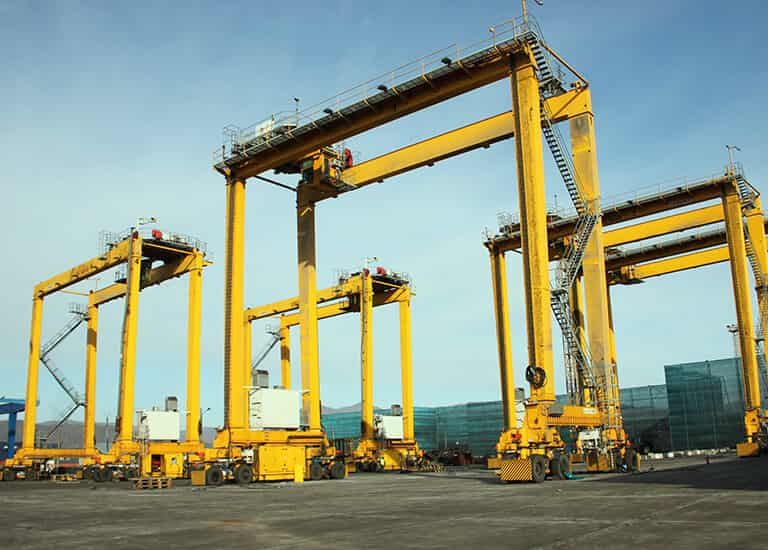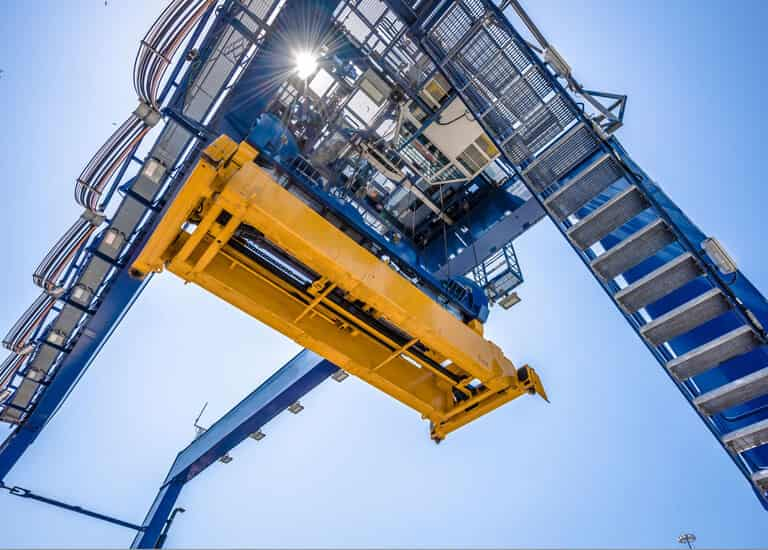Projects
Rubber Tyred Gantry (RTG) Crane Specification
Lifting Capacity: 20~45 ton
Span: 12~28 m
Lifting Height: m
Working Class: A6
Note: We can design and manufacture the crane according your requirments and working conditions.
What is Rubber Tyred Gantry (RTG) Crane:
A Rubber Tyred Gantry Crane (RTG) is a specialized material handling and container lifting equipment commonly employed in ports, container yards, and intermodal terminals. This versatile crane is characterized by its ability to travel on rubber tires, providing flexibility in maneuvering around the container stacking area. RTGs are a vital component of container handling operation, contributing to the efficiency and productivity of container terminals worldwide.
Rubber Tyred Gantry Crane Specification and Dimensions:
The Rubber Tired Gantry Crane for sale comes with variable specifications, tailored to both manufacturer specifications and customer needs.
Key specifications parameters for RTG cranes include lifting capacity, ranging typically lifting capacity up to 100 tons under the spreader. The span length indicates how wide the crane can extend over container rows, falling within the 22 to 28 meters range. Hoisting height signifies rubber tyred gantry crane capability to lift containers, typically ranging from one over three to one over six containers high. The lifting speed, measuring how fast the crane can raise or lower containers, usually falls between 12 to 46 meters per minute. The rubber tyred gantry crane speed, determining its movement along the yard, typically ranges from 45 to 90 meters per minute. Operating temperature is also a critical factor, with most RTG cranes designed to operate within a temperature range of -20°C to 40°C.
| Capacity Of Spreader | T | 30.5 | 35 | 40.5 | ||
|---|---|---|---|---|---|---|
| Working Duty | A6 | A6 | A6 | |||
| Span(M) | S | 23.47 | 23.47 | 23.47 | ||
| Base(M) | B | 7.4 | 7.4 | 7.5 | ||
| Lifting Height(M) | H | 15.4 | 15.4 | 18.2 | ||
| Speed | Hoisting | With Full Load | M/Min | 12 | 12 | 23 |
| Only With Spreader | 24 | 24 | 46 | |||
| Traverse | 70 | 70 | 70 | |||
| Travailing | With Full Load | 45 | 45 | 45 | ||
| Only With Spreader | 90 | 90 | 90 | |||
| Main Dimensions | L | 25370 | 25370 | 25395 | ||
| H1 | 22030 | 22334 | 25134 | |||
| L1 | 905 | 905 | 905 | |||
| L2 | 950 | 950 | 975 | |||
| Total Power Of Diesel Motor | kW | ~305 | ~305 | ~400 | ||
| Total Power Of Generator | kVA | ~518 | ~595 | ~720 | ||
| Max. Working Load Of Wheel | kN | 273 | 287 | 320 | ||
Container Spreaders for RTG Cranes

| Container Model | 20' Container | 40' Container | |
| Lifting capacity | 32 ton | 40.5 ton | |
| Rotation speed | 0-1.5 r/min | 0-1.5 r/min | |
| Power supply | AC 380/3/50 | AC 380/3/50 | |
| Size(mm) | L | 5853 | 11985 |
| S | 2260 | 2260 | |
| A | 6056 | 12188 | |
| B | 2436 | 2436 | |
| H | 3620 | 3887 | |

| Container Model | 20' 40' 45' Container | |
| Lifting capacity | 40.5 ton (under spreader) | |
| Rotation speed | 0-1.5 r/min | |
| Rotation time | 1.5S | |
| Telescopic action time | 40S | |
| Hydraulic system | 10MPa | |
| Power supply | AC 380/3/50 | |
| Self-weight | 12 ton | |
| Size(mm) | L | 5853-11985-13510 |
| S | 2260 | |
| A | 6053-12185-13710 | |
| B | 2436 | |
| A1 | 5000 | |
| B1 | 1200 | |
| H | 3620 | |
RTG Crane Height:
Rubber tyre gantry crane (RTGs) are available with spans of between five and nine containers wide (plus a truck lane) and with hoisting heights from 1 over 3 to 1 over 6 containers high. Supplied with eight rope reeving anti-sway system and drive systems, the RTG delivers exceptional productivity and reliability in container stacking.
Features of Rubber Tyred Gantry Cranes:
- Mobility: RTGs are mounted on wheels, allowing them to move freely within the container yard. This mobility enables quick and precise positioning of containers, reducing the time required for loading and unloading operation.
- Container Handling Capacity: RTGs are designed to lift and move standard containers, with the capacity to handle one or more containers simultaneously. This makes them suitable for high-throughput container terminals.
- Versatility: These RTG cranes specification are adaptable to various container sizes and types. The spreader, which attaches to the rubber tyred gantry crane's hoisting mechanism, can be adjusted to accommodate different container dimensions.
- Height and Reach: RTGs are capable of lifting containers to significant heights, allowing for efficient stacking. The RTG crane specification reach is designed to cover a wide area, maximizing the use of available storage space.
- Power Options: RTGs can be powered by either diesel engines or electricity. The choice of power source depends on factors such as environmental considerations, cost, and the availability of suitable power infrastructure.
- Control Systems: Modern RTGs are equipped with advanced control systems, allowing for precise and automated container handling. These systems often include features like anti-collision technology and remote monitoring for enhanced safety and RTG crane operational efficiency.
- Weather Resistance: The rubber tires and corrosion-resistant materials used in RTG construction make them well-suited to withstand various environmental conditions, including exposure to saltwater in maritime environments.
- Operator Cabin: RTGs are typically equipped with an operator cabin that provides a clear view of the container yard. The cabin is designed for operator comfort and efficiency, featuring ergonomic controls and climate control systems.
- Safety Features: Safety is paramount in container handling operation. RTGs are equipped with safety features such as overload protection, emergency braking systems, and audible alarms to ensure the well-being of both operators and other personnel in the vicinity.
In summary, Rubber Tyred Gantry Cranes specification play a crucial role in the global logistics and shipping industry by facilitating the efficient handling of containers in ports and terminals. Their mobility, capacity, and adaptability contribute to the streamlined flow of goods, making them indispensable in the modern containerized transportation system.
Rubber Tyred Gantry Crane Specification Factors:
Rubber Tyred Gantry Cranes (RTGs) are essential in container handling at ports and container yards. When specifying RTG cranes specification, several crucial considerations should be taken into account to ensure optimal performance, safety, and efficiency. Here are some key RTG cranes specification factors:
1. Capacity and Span:
Capacity: Determine the maximum load capacity the rubber tyred gantry crane needs to handle. Consider both current and future requirements.
Span: The span is the distance between the outer edges of the two legs of the crane. It should be designed to cover the required storage area efficiently.
2. Lifting Height:
Define the maximum height the rubber tyred gantry crane needs to lift containers. Consider factors like container stacking and future expansion.
3. Wheel Configuration:
Decide on the wheel configuration based on the operational requirements and surface conditions. RTGs can have different wheel arrangements, such as 4x2, 6x2, or 8x4.
4. Power Supply:
Choose between dieselpowered or electricpowered RTGs based on environmental considerations, cost, and availability of power sources.
5. Container Handling:
Specify the type of spreader required for container handling, considering factors such as single or twinlift spreaders, and the size and type of containers to be handled.
6. Automation and Control System:
Determine the level of automation required. Advanced control systems can improve efficiency and reduce the risk of accidents. Automation can include features like autosteering, autopositioning, and remote monitoring.
7. Speed and Acceleration:
Specify the desired travel speed and acceleration for efficient container movement. Consider factors like operational requirements and safety.
8. Environmental Conditions:
Consider the environmental conditions of the operating area, such as wind speed, temperature range, and exposure to corrosive elements. This will influence the choice of materials and coatings.
9. Safety Features:
Ensure that the rubber tyred gantry crane is equipped with essential safety features such as anticollision systems, overload protection, emergency braking, and fire prevention measures.
10. Maintenance and Serviceability:
Specify features that facilitate easy maintenance, such as accessible components, diagnostic systems, and remote monitoring capabilities.
By carefully considering these factors during the specification phase, you can ensure that the Rubber Tyred Gantry Crane meets the specific needs of the container handling operation and operates efficiently and safely.
Rubber tyred gantry (RTG) crane parts name:
The Rubber Tyred Gantry (RTG) crane, also known as a Transtainer, consists of several key RTG crane parts name, including:- Steel Frame: The steel frame serves as the structural backbone of the RTG crane specification, providing support and stability for all the other components. It forms the main framework of the crane.
- Hoisting Mechanism: The hoisting mechanism is responsible for lifting and lowering containers. It includes a winch or hoist that is connected to the spreader, enabling the crane to handle containers efficiently.
- Minimum Slewing Mechanism: The minimum slewing mechanism allows the RTG crane to make small horizontal adjustments to position the spreader precisely over the container for loading or unloading operation.
- Spreader Anti-Shaking Mechanism: This mechanism helps stabilize the spreader and reduce sway when picking up or setting down containers, ensuring safer and more precise handling.
- Crane Travel Mechanism: The crane travel mechanism involves the rubber tires and drive system that enable the rubber tyred gantry crane to move horizontally within the container yard. RTG cranes can travel along a designated path.
- Turning Mechanism: The turning mechanism allows the RTG crane to pivot around its vertical axis, enabling it to change direction and align with the rows of containers in the storage yard.
- Trolley Traverse Mechanism: This mechanism facilitates lateral movement of the spreader along the crane's gantry structure, allowing the crane to reach containers located to the sides.
- Container Spreader: The spreader is the attachment that connects to the corners of containers for lifting and moving them. It can be adjusted to accommodate different container sizes.
- Diesel Generating Sets: In some cases, RTG cranes are equipped with diesel generators to provide power when an external electrical supply is not available, offering greater operational flexibility.
- Electrical Equipment: RTG cranes are equipped with electrical components and control systems for precise operation, safety features, and automation. These include motor controls, sensors, and safety interlocks.
- Accessory Equipment for Safety: Various safety features and accessories, such as anti-collision systems, load monitoring devices, and emergency stop controls, are incorporated to ensure safe crane RTG crane operation.
These RTG crane parts work together to enable the RTG crane specification to efficiently and safely handle containers in container terminals and storage yards. RTG crane parts name design and functionality contribute to the rubber tyred gantry crane's productivity and the overall logistics of container handling RTG crane operation.
Maintenance of RTG Crane Parts:
The maintenance of Rubber Tyred Gantry RTG crane parts is essential to ensure optimal performance, longevity, and safety. RTG crane parts regular maintenance helps prevent breakdowns, reduces downtime, and extends the life of the equipment. Here are some key aspects of RTG crane parts maintenance, focusing on various parts:
- Structural Components: Regularly inspect the main structural components, such as the frame, boom, and spreader, for signs of wear, corrosion, or damage. Perform nondestructive testing (NDT) as needed to assess the integrity of critical structural elements.
- Wheel Assemblies: Inspect the wheels, tires, and axles for wear and tear. Replace any damaged or wornout components promptly. Ensure proper wheel alignment to prevent uneven wear and stress on the rubber tyred gantry crane structure.
- Drive System: Regularly check the drive system, including motors, gearboxes, and brakes, for proper functioning. Lubricate moving parts as per the manufacturer's recommendations to prevent friction and wear.
- Lifting Mechanism: Inspect the hoisting system, including the wire ropes, sheaves, and hooks, for wear and deformation. Grease and lubricate the lifting mechanism to ensure smooth operation and prevent corrosion.
- Control System: Check the control system for any faults or malfunctions. Update software as necessary to improve performance and safety. Calibrate sensors and control interfaces to maintain accuracy in RTG crane operation.
- Electrical Components: Inspect electrical components, such as cables, connectors, and switches, for signs of wear or damage. Check for loose connections and corrosion, and replace any faulty components.
- Safety Features: Regularly test and calibrate safety features, including anticollision systems, overload protection, emergency braking, and limit switches. Ensure that emergency stop buttons and other safety devices are functional.
- Cabin and Operator Interfaces: Maintain the operator cabin in good condition, ensuring that visibility is not compromised. Check and calibrate control interfaces to ensure the operator has accurate control over the crane.
- Environmental Protection: Implement measures to protect the crane from environmental factors, such as applying corrosionresistant coatings and sealing electrical components against moisture.
Regular, proactive RTG crane parts maintenance is critical for the safe and efficient operation of Rubber Tyred Gantry Cranes. Adhering to a welldefined RTG crane parts maintenance schedule and promptly addressing any issues that arise will contribute to the overall reliability of the equipment.
RTG crane safe operation:
Rubber Tyred Gantry (RTG) Crane safe operation involves following industry best practices and adhering to safety guidelines. Here are key considerations for the safe RTG crane operation:
- Pre-Operation Inspection: Conduct a thorough pre-operation inspection of the RTG Crane before each use; Check for any visible damage, loose components, or fluid leaks. Verify that safety devices and emergency systems are functioning properly.
- Load Capacity: Do not exceed the rated load capacity of the crane; Ensure that the load is properly secured and within the specified weight limits.
- Weather Conditions: Consider weather conditions before operating the crane. High winds, storms, or other adverse weather conditions may impact RTG crane operation.
- Ground Conditions: Ensure that the ground conditions are suitable for the RTG crane operation; Stabilize the crane on a level surface to prevent tipping.
- Communication: Maintain clear communication between the crane operator and ground personnel; Use standardized signals and communication methods.
- Proximity Awareness: Be aware of the proximity of the crane to other structures, equipment, and personnel; Maintain a safe clearance distance to prevent collisions.
- Emergency Procedures: Familiarize operators with emergency procedures, including shutdown protocols and evacuation plans; Conduct regular emergency drills.
- Maintenance: Implement a routine maintenance schedule for the RTG Crane; Regularly inspect and maintain all components, including mechanical, electrical, and structural parts.
By adhering to these guidelines and promoting a safety-first culture, operators can contribute to the RTG crane safe and efficient operation. Regular training, maintenance, and adherence to safety protocols are essential components of a comprehensive safety program.






